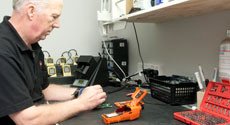
Gas detectors use sensors to measure the levels of target gases. Why calibrate new sensors? Sensor performance is prone to drift over time and with exposure to gaseous environments. That’s why you need to calibrate them regularly – to ensure the sensors are working accurately.
What does the calibration process involve? Calibration involves testing the sensors against a known calibration standard and adjusting to correct for any inaccuracies. The “known calibration standard” is the contents of your calibration gas bottle.
Why do I still need to calibrate even when the gas detector is fairly new? Well, as soon as it enters into service and gets exposed to gas, the sensors start to work. As soon as they start working they become susceptible to ‘drift’. And other gases can actually poison some sensors, putting them out of calibration.
For example, LEL sensors can be badly affected by exposure to silicon-based products.
So, best practice is regular calibrations in line with the manufacturer’s recommendation. Many gas detectors come with docking stations that perform both bump tests and full calibrations at your own premises. If not, gas detector service agencies will perform calibrations for you.


